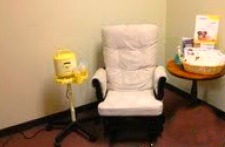Working and Breastfeeding Employment Laws (Part 1)
Working and breastfeeding employment laws were put in place to enable nursing mothers to continue breastfeeding even when they return to work after maternity leave.

On March 23rd of 2010 the Patient Protection and Affordable Care Act was signed into law and amended the Fair Labor Standards Act (FLSA).
According to the law, an employer is required to provide "reasonable break time for an employee to express breast milk for her nursing child for 1 year after the child’s birth each time such employee has need to express the milk."¹
An employer shall also provide "a place, other than a bathroom, that is shielded from view and free from intrusion from coworkers and the public, which may be used by an employee to express breast milk."¹
Does your company follow this law? Share your experience here.
Understanding Room Requirements


The law doesn’t give specifics about what the place for expressing breast milk should be.
A 4 X 5 room? A conference room? A shielded hallway?
Possibly any of the above. In fact, it doesn’t even have to be a permanent room. As long as this room is available for EVERY nursing mother ANY time they may need it.
The room can’t be too small, otherwise ALL the nursing mothers at ANY time won't be able to use it.
It can’t be just a big room where dozens of ladies pump at the same time without any privacy. The room has to be: “shielded from view and free from intrusion from coworkers and the public”. So if it is a big room, dividers are required.
It should also be a room “which may be used by an employee to express breast milk”, so it should be a functional space for milk expression.
Most companies today are very supportive of breastfeeding and are eager to provide a cozy lactation room for new mothers. Some even equip the room with nice add-ons for improved pumping experience.
Typically, this is what an average lactation room should be equipped with (not required by law):
Chair
Table
Lock on the door
Electric outlet
A nicer lactation room may also have:
|
Rental pumps Microwave Disinfectant wipes
Recliner Footstool Sink |
Fridge Wall clock Bulletin board
Pleasant décor Educational materials Music player |
|
Rental pumps Microwave
Disinfectant wipes Recliner Footstool Sink |
Fridge Wall clock
Bulletin board Pleasant décor Educational materials Music player |
What is lactation room like where you work? Share your experience here.
Understanding "Reasonable Break Time" Requirement
Since the concept “reasonable” is relative, US Breastfeeding Committee offers some clarifications.
On average a new mom needs to pump 2-3 times during a standard 8.5-hour workday. A typical pumping session lasts 15-20 minutes. Add to it the time you need to set up, clean after and walk from and to your desk, and it can easily add up to 30 minutes.
How many breaks are you allowed to take?
In theory: An employee is allowed to take a break "each time such employee has need to express the milk".
In practice: An infant eats every 2 hours, so ideally during a typical 8.5-hour day you will need to pump at least 3 times. If you are only paid for 2 breaks, try pumping during lunch too.
If this is how much time you need or even more than that, discuss it with your manager. Understand how much paid break time you have and arrange for any extra time needed. Don’t expect to be paid for this extra time. Here is an example:
Let's say that all the employees of your department are entitled to two paid 10-minute breaks, so 20 minutes total. You, however, need three 20-minute breaks to pump, so 60 minutes total.
In this case, you will get
paid for 20 minutes of break time and then ask your boss how he wants you to
handle the other 40 minutes. He can't deny your request. He
simply needs to give you options: staying later or coming in earlier to make up for this time, clocking out for the break time or using some of you paid time-off.
Making your manager aware of how much time you need for pumping
is a good practice. In this case, he will always be there to back you up,
if someone inquires about your absence. What is your manager's attitude to your pumping breaks? Click here to share!
The law says that an employee is entitled to a break “each time such employee has need to express the milk”. Do not abuse this right. And remember, your employer doesn’t have to pay you for the break time that exceeds what other employees get paid. So by taking unreasonably long or often breaks the only person you are hurting is you.
Another thing I learnt from an attorney is that at UNPAID breaks you have to be completely relieved from your duties. So if you don’t get paid for your pumping break, no one can force you to pump at your desk, while working.
Continue to Working and Breastfeeding Employment Laws (Part 2)
¹ Source: US Department of Labor Wage and Hour Division. Break Time for Nursing Mothers under the FLSA.
Home › Breastfeeding and Work › Employment Laws (Part 1)
And How Does Your Company Follow the Law?
Share Your Experience!
Does your company support nursing mothers? Is there a lactation room and what does it look like? Are pumping breaks provided? What other support and education does the company provide? If none of the above, did you talk to someone about it?










